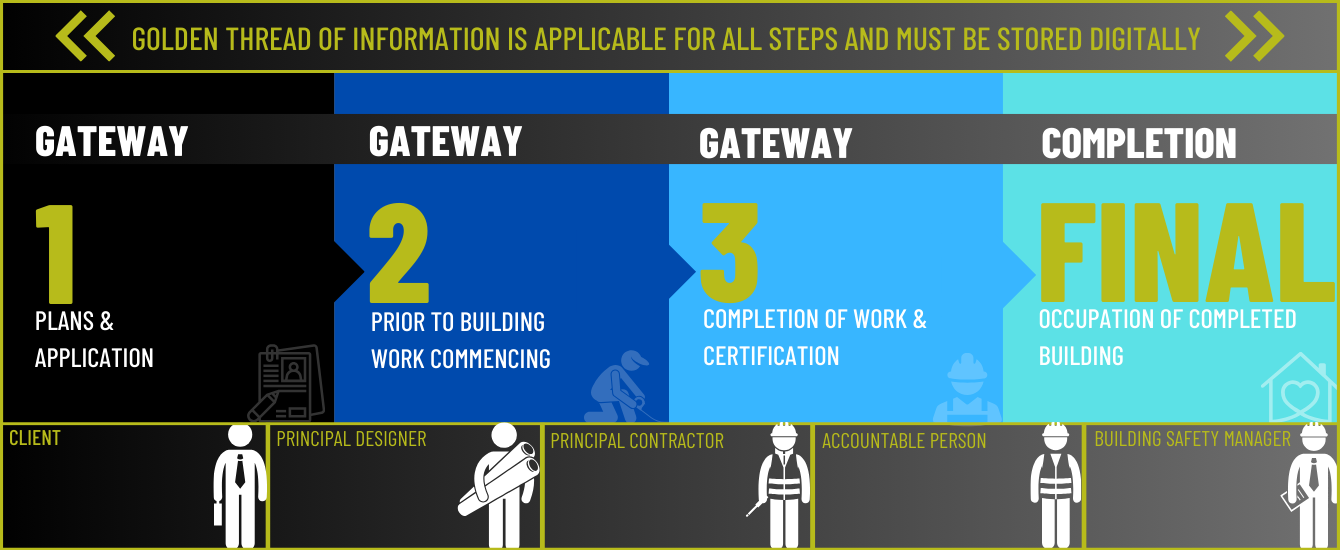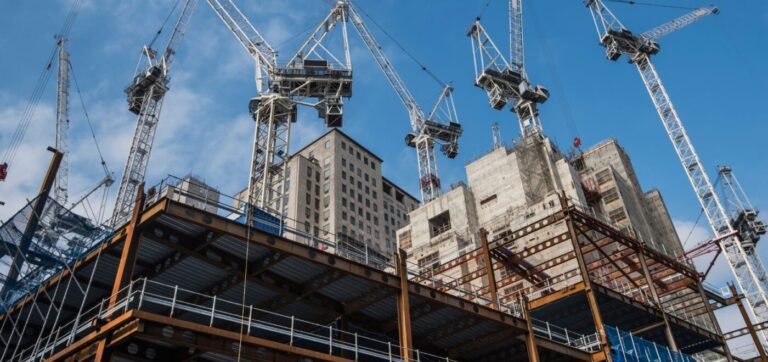This month, the next step of the Building Safety Act will be made part of active legislation. Gateway 3 is an important stage that will require transparent building information, along with evidence of the build to support the application.
Gateway 3 specifically looks at the completion of building works. Throughout this article, we will look at providing a comprehensive overview of Gateway 3 within the Building Safety Act. We will also look at what is needed at the application stage, how to collaborate the information required to hand into the BSR (Building Safety Regulator), and ultimately receive the Completion Certificate.
Before we delve into Gateway 3, it’s important to understand what the Building Safety Act of 2022 is.
WHAT IS THE BUILDING SAFETY ACT 2022?
The Building Safety Act 2022 is a legislation in the United Kingdom that aims to ensure the safety of people in and around buildings and to improve the standards of construction. This Act consists of six parts, each addressing different aspects of building safety and regulation.
Part 1 of the Building Safety Act 2022 provides an introduction to the Act and outlines its objectives to secure the safety of individuals and enhance the quality of buildings. It sets the foundation for the regulatory framework and establishes the building safety regulator and its functions concerning buildings in England.
Part 2 focuses on the duties and responsibilities of the building safety regulator. It outlines the objectives and regulatory principles of the regulator, including facilitating building safety in higher-risk buildings, conducting regular reviews of building safety and standards, and promoting industry competence and improvement of building inspectors.
In addition, the Building Safety Act 2022 introduces important changes to existing legislation. Part 3 of the Act amends the Building Act 1984 and introduces provisions related to the building safety regulator. These amendments grant regulatory powers to the building safety regulator and define its role in overseeing building safety processes and procedures.
The introduction of the Building Safety Act 2022 marks a significant shift in the approach to building safety in the UK. It aims to improve accountability, competence, and oversight within the construction industry to prevent future building failures and protect the safety of occupants. The Act also introduces new regulations and guidelines that impact the design and construction of buildings, emphasising the importance of adhering to higher safety standards.
Part 4 of the Building Safety Act focuses on leaseholder protection, remediation, and redress. This part of the Act aims to provide support and remedies for leaseholders who may be affected by building safety issues.
The penultimate section of the Building Safety Act, Part 5 is titled “Redress provisions” and it focuses on providing recourse and remedies for individuals affected by building safety issues, particularly in England. This part aims to protect leaseholders and tenants by establishing mechanisms for seeking redress in situations where building safety defects and risks are identified. Finally, Part 6 looks at ‘General’ sections, not within the first 5 parts.
These changes are expected to have a profound impact on the industry, with the Act placing a greater emphasis on building safety and the responsibilities of those involved in the construction process.

BUILDING SAFETY ACT TIMELINE
The Building Safety Act 2022 introduces several changes and timelines to enhance building safety. While the specific timelines may vary depending on the aspect being addressed, here is a general overview:
- April 28, 2022: The Building Safety Act 2022 received Royal Assent.
- Within 12 to 18 months of the Act: The bulk of changes have or are expected to come into effect. These changes include the establishment of the Building Advisory Committee as an arm of the Building Safety Regulator, aimed at improving oversight of new building projects.
- May 24, 2023: Key changes to support the implementation of the Building Safety Act are scheduled to take effect. The timeline provided by Build UK, highlights the dates when these changes will be implemented.
It’s important to note that specific timelines and deadlines may vary for different aspects and requirements of the Act. For more detailed information on specific timelines and their implementation, it is advisable to refer to official government guidance and industry resources that provide comprehensive details and updates on the Building Safety Act.
GATEWAYS OF THE BUILDING SAFETY ACT
The Building Safety Act contains three gateways that act as controls at key points during the construction process. This helps to oversee standards and ensures quality assurance and each step.

Information is sourced from goldenthread.co.uk
GATEWAY 1 - PLANS & APPLICATION STAGE
- This is the initial gateway where developers and designers must demonstrate how they plan to meet building safety requirements during the planning and design phase.
- Developers and designers are required to submit a Fire Statement and a Fire Safety Compliance Certificate at this stage to outline how they intend to address fire safety risks in the building.
- The building’s proposed design and safety measures are reviewed and assessed to ensure they meet the necessary safety standards.
GATEWAY 2 - PRIOR TO BUILDING WORK COMMENCING
- Gateway 2 is reached when the developer submits a Full Plans Application to the local building control authority.
- This stage involves a detailed review of the building’s plans, specifications, and construction methods to ensure they comply with building regulations, including fire safety requirements.
- If the plans meet the necessary standards, the authority will issue a Building Control Approval.
GATEWAY 3 - COMPLETION OF WORK & CERTIFICATION
- The third gateway involves the oversight of construction and the issuance of a Building Control Certificate of Completion.
- Building control inspectors monitor the construction process, including reviewing the all-important ‘golden thread(1) to ensure that it aligns with the approved plans and adheres to safety standards.
These gateways are designed to ensure that building safety is considered at various stages of a building’s life cycle, from initial planning and design through to construction and completion. They help to provide a structured approach to building safety and enhance accountability, particularly for high-rise and complex buildings. Please note, that the specifics of the Building Safety Act may evolve over time, so it’s important to refer to the most recent legislation and guidance for the latest information.
POSITIVES AND NEGATIVES OF GATEWAY REVIEWS IN THE BUILDING SAFETY ACT
POSITIVES
POSITIVES
NEGATIVES
- 1. Enhanced Safety Oversight: Gateway reviews provide an additional layer of oversight throughout the different stages of a building’s lifecycle, ensuring that safety considerations are continually assessed and addressed.
- 2. Early Identification of Issues: By conducting reviews at key stages, potential safety issues can be identified and addressed early in the design and construction process, reducing the likelihood of costly and dangerous problems emerging later.
- 3. Accountability: Gateway reviews can help establish clear lines of responsibility and accountability for building safety, making it easier to identify who is responsible for ensuring safety compliance at each stage.
- 4. Improved Communication: The reviews require collaboration and communication between various stakeholders, including developers, designers, contractors, and building control authorities, fostering a more cooperative and transparent approach to safety.
- 5. Public Confidence: The presence of gateway reviews may improve public confidence in the safety of high-rise buildings, as it demonstrates that safety is being taken seriously and rigorously assessed.
NEGATIVES
- 1. Time-Consuming: Conducting gateway reviews at multiple stages of a building’s development can add time to the construction process. Delays may be seen as a negative aspect, especially when developers are eager to complete projects quickly.
- 2. Costs: Additional reviews and oversight can increase project costs, which may be passed on to buyers or tenants, potentially making housing less affordable. When looking at Gateway 3, Spatial Dimensions are happy to help. Our team is well-skilled when dealing with these requirements, saving you and your client’s money. Contact us here for more info.
WHAT IS GATEWAY 3?
Gateway 3 is required once building works are completed. It’s at this point contractors should submit their application to the Building Safety Regulator. They must also submit signed declarations from the principal designer and contractor that affirm the regulatory complaince. This documentation is to show the building lines up with building requirements.
It requires the insurance of a Completion Certificate from the Building Safety Regulator to signify that the construction work has been completed to standard and the building meets the necessary safety standards to be occupied.
When referring to the ‘as-built’ building, plans and documents are incorporated as part of the Golden Thread(1) of information, which can be then passed to the building owners.
Once the Building Safety Regulator is happy with the design and construction the Completion Certificate is awarded. In short, this means the building can now be occupied safely, with information submitted prior to being occupied.
Everything must be verified on a digital record.
WHAT IS NEEDED FOR GATEYWAY 3?
All Gateway 3 applications must include as-built drawings, contact us for more information about this. It should include any on-site features that are in the realms of public health systems, mechanical components, and electrical components. Everything must be verified on a digital record.
A Safety Case Report should be included in the handover, highlighting all safety standards have been met.
This should deliver culture change as building regulations compliance and building safety are considered through design and construction. This will be opposed to late in the process when mitigation measures are needed.

(1)The Golden Thread is like a trusty tool that keeps building safety information organised and managed. Think of it as a concept that brings duty holders and accountable persons together to create and maintain a database of easily accessible information. This valuable resource is available to various stakeholders involved in the building’s life cycle, ensuring that everyone has the necessary information at their fingertips. It’s a way of working collaboratively to keep everyone on the same page and make informed decisions for the safety and well-being of the building and its occupants.
If you have any questions about anything in this document, feel free to contact us. Keep an eye out on our website for further information about Gateway 3 as we look to assist you moving forward!





